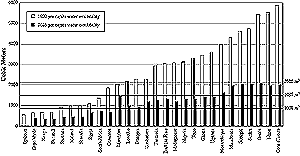10.2.1.3. Demography and Water Resources

Figure 10-7: Water scarcity and people in Africa (Sharma et al., 1996). |
Availability of water in sub-Saharan Africa (SSA) is highly
variable. Only the humid tropical zones in central and west Africa have abundant
water. Water availability varies considerably within countries as well, influenced
by physical characteristics and seasonal patterns of rainfall. According to
Sharma et al. (1996), eight countries were suffering from water stress
or scarcity in 1990; this situation is getting worse as a consequence of rapid
population growth, expanding urbanization, and increased economic development.
By 2000, about 300 million Africans risk living in a water-scarce environment.
Moreover, by 2025, the number of countries experiencing water stress will rise
to 18—affecting 600 million people (World Bank, 1995). Figure
10-7 shows how countries will shift from water surplus to water scarcity
as a result of population changes alone between 1990 and 2025, using a per capita
water-scarcity limit of 1,000 m3 yr-1. Scarcity statistics
also can be associated with challenges to international water resources: Many
such basins face water stress or scarcity (Sharma et al., 1996). Long-term
precipitation records from the Sahara give a clear indication of declining precipitation
in that region (UNEP, 1997). These declines in precipitation register as reduced
hydrological discharges in major river basins in the subhumid zones.
Given the climate scenarios discussed in this report, it is apparent that several
countries will face water availability restrictions by the middle of the 21st
century, if current consumption trends persist. Pottinger (1997) discusses some
concerns about future water availability in South Africa. These examples show
that the combination of demographic trends and climate change is likely to cause
economically significant connstraints in some parts of Africa.
|